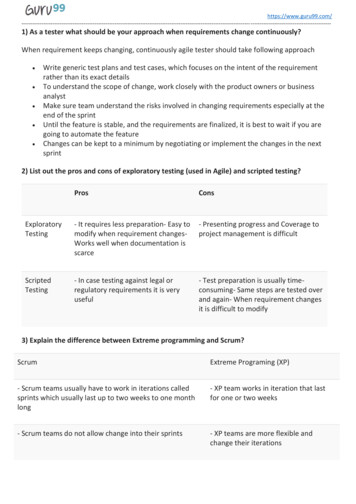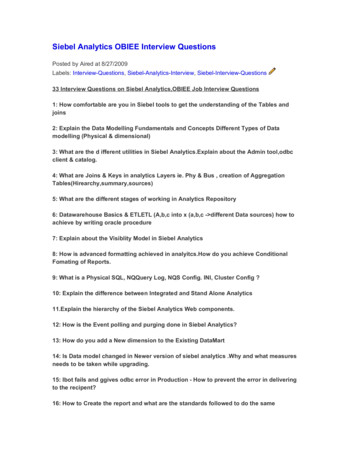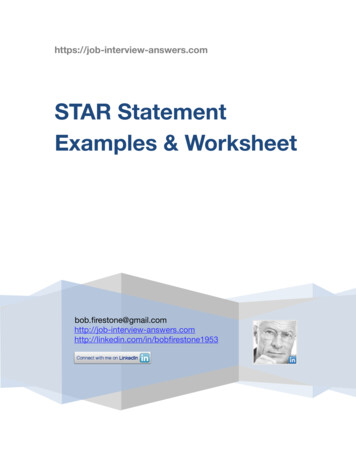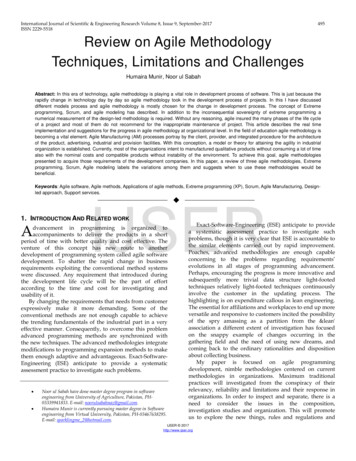
Transcription
------------------------------------------1) As a tester what should be your approach when requirements change continuously?When requirement keeps changing, continuously agile tester should take following approach Write generic test plans and test cases, which focuses on the intent of the requirementrather than its exact detailsTo understand the scope of change, work closely with the product owners or businessanalystMake sure team understand the risks involved in changing requirements especially at theend of the sprintUntil the feature is stable, and the requirements are finalized, it is best to wait if you aregoing to automate the featureChanges can be kept to a minimum by negotiating or implement the changes in the nextsprint2) List out the pros and cons of exploratory testing (used in Agile) and scripted testing?ProsConsExploratoryTesting- It requires less preparation- Easy tomodify when requirement changesWorks well when documentation isscarce- Presenting progress and Coverage toproject management is difficultScriptedTesting- In case testing against legal orregulatory requirements it is veryuseful- Test preparation is usually timeconsuming- Same steps are tested overand again- When requirement changesit is difficult to modify3) Explain the difference between Extreme programming and Scrum?ScrumExtreme Programing (XP)- Scrum teams usually have to work in iterations calledsprints which usually last up to two weeks to one monthlong- XP team works in iteration that lastfor one or two weeks- Scrum teams do not allow change into their sprints- XP teams are more flexible andchange their iterations
------------------------------------------- In scrum, the product owner prioritizes the productbacklog but the team decides the sequence in which theywill develop the backlog items- XP team work in strict priority order,features developed are prioritized bythe customer- Scrum does not prescribe any engineering practices- XP does prescribe engineeringpractices4) What is an epic, user stories and task?Epic: A customer described software feature that is itemized in the product backlog is known asepic. Epics are sub-divided into storiesUser Stories: From the client perspective user stories are prepared which defines project orbusiness functions, and it is delivered in a particular sprint as expected.Task: Further down user stories are broken down into different task5) Explain what is re-factoring?To improve the performance, the existing code is modified; this is re-factoring. During re-factoringthe code functionality remains same
------------------------------------------6) Explain how you can measure the velocity of the sprint with varying team capacity?When planning a sprint usually, the velocity of the sprint is measured on the basis of professionaljudgement based on historical data. However, the mathematical formula used to measure thevelocity of the sprint are, first – completed story points X team capacity: If you measure capacity as a percentage ofa 40 hours weeksSecond – completed story points / team capacity: If you measure capacity in man-hoursFor our scenario second method is applicable.7) Mention the key difference between sprint backlog and product backlog?Product backlog: It contains a list of all desired features and is owned by the product owner.Sprint backlog: It is a subset of the product backlog owned by development team and commits todeliver it in a sprint. It is created in Sprint Planning Meeting8) In Agile mention what is the difference between the Incremental and Iterative development?Iterative: Iterative method is a continuous process of software development where the softwaredevelopment cycles are repeated (Sprint & Releases) till the final product is achieved.Release 1: Sprint 1, 2 nRelease n: Sprint 1, 2 .nIncremental: Incremental development segregates the system functionality into increments orportions. In each increment, each segment of functionality is delivered through cross-disciplinework, from the requirements to the deployment.9) Explain what is Spike and Zero sprint in Agile? What is the purpose of it?Sprint Zero: It is introduced to perform some research before initiating the first sprint. Usuallythis sprint is used during the start of the project for activities like setting developmentenvironment, preparing product backlog and so on.Spikes: Spikes are type of stories that are used for activities like research, exploration, design andeven prototyping. In between sprints, you can take spikes for the work related to any technical ordesign issue. Spikes are of two types Technical Spikes and Functional Spikes.
------------------------------------------10) What is test driven development?Test driven development or TDD is also known as test-driven design. In this method, developerfirst writes an automated test case which describes new function or improvement and thencreates small codes to pass that test, and later re-factors the new code to meet the acceptablestandards.11) Prototypes and Wireframes are widely used as part of?Prototypes and Wireframes are prototypes that are widely used as part of Empirical Design.12) Explain what is Application Binary Interface?Across different system platforms and environments a specification defining requirements forportability of applications in binary form is known as Application Binary Interface.13) Explain in Agile, burn-up and burn-down chart?To track the project progress burnup and burn down, charts are used.Burnup Chart: It shows the progress of stories done over time.Burndown Chart: It shows how much work was left to do overtime.14) Explain what is Scrum ban?Scrum ban is a software development model based on Scrum and Kanban. It is specially designedfor project that requires frequent maintenance, having unexpected user stories and programmingerrors. Using these approach, the team’s workflow is guided in a way that allows minimumcompletion time for each user story or programming error.15) What is story points/efforts/ scales?It is used to discuss the difficulty of the story without assigning actual hours. The most commonscale used is a Fibonacci sequence ( 1,2,3,5,8,13, .100) although some teams use linear scale(1,2,3,4 .), Powers of 2 (1,2,4,8 ) and cloth size (XS, S ,M,L, XL).16) Explain what is tracer bullet?The tracer bullet is a spike with the current architecture, the current set of best practices, currenttechnology set which results in production quality code. It is not a throw away code but might justbe a narrow implementation of the functionality.
------------------------------------------17) What is a test stub?A test stub is a small code that replaces an undeveloped or fully developed component within asystem being tested. Test stub is designed in such a way that it mimics the actual component bygenerating specifically known outputs and substitute the actual component.18) What are the differences between RUP (Rational Unified Process) and Scrummethodologies?RUPSCRUM- Formal Cycle is defined across four phases, butsome workflows can be concurrent- Each sprint is a complete cycle- Formal project plan, associated with multipleiterations is used.- No end to end project plan. Each nextiteration plan is determined at the endof the current iteration- Scope is predefined ahead of the project start anddocumented in the scope document. During theproject, scope can be revised.- It uses a project backlog instead ofscope scrum- Artifacts include Scope Document, formal functionalrequirements package, system architecturedocument, development plan, test scripts, etc.- Operational software is the only formalartifacts- Recommended for long term, large, enterprise levelprojects with medium to high complexity- Recommended for quick enhancementsand organization that are not dependenton a deadline19) Why Continuous Integration is important for Agile?Continuous Integration is important for Agile for following reasons. It helps to maintain release schedule on time by detecting bugs or integration errorsDue to frequent agile code delivery usually every sprint of 2-3 weeks, stable quality of buildis a must and continuous integration ensures thatIn helps to maintain the quality and bug free state of code-baseContinuous integration helps to check the impact of work on branches to the main trunk ifdevelopment work is going on branches using automatic building and merging function
------------------------------------------20) What testing is done during Agile?The primary testing activities during Agile is automated unit testing and exploratory testing.Though, depending on project requirements, a tester may execute Functional and Non-functionaltests on the Application Under Test (AUT).21) Explain what is Velocity in Agile?Velocity is a metric that is calculated by addition of all efforts estimates related with user storiescompleted in an iteration. It figures out how much work Agile can complete in a sprint and howmuch time will it need to finish a project.22) What are the qualities of a good Agile tester should have?A good Agile tester should have following qualities It should be able to understand the requirements quicklyAgile tester should know Agile principals and concepts wellAs requirements keep changing, tester should understand the risk involve in itBased on the requirements Agile tester should be able to prioritize the workContinue communication between business associates, developers and tester is must23) Who are all involved in the Agile team?In agile the two main leads are Scrum Masters: It coordinates most of the inputs and outputs required for an agileprogramDevelopment Managers: They hire right people and develop them with the team24) Mention in detail what are the role’s of Scrum Master?Scrum Master key responsibilities involves Understand the requirements and turn them into working softwareMonitoring and TrackingReporting and CommunicationProcess Check MasterQuality MasterResolve ImpedimentsResolve ConflictsShield the team and performance feedbackLead all the meetings and resolve obstacles
------------------------------------------25) Mention what are the Agile quality strategies?Agile quality strategies are Re-factoringNon-solo developmentStatic and dynamic code analysisReviews and InspectionIteration/sprint demosAll hands demoLight weight milestone reviewsShort feedback cyclesStandards and guidelines26) Mention what are the Tools that can be useful for screenshots while working on Agileprojects?While working on Agile projects you can use tools like BugDiggerBugShootingqTraceSnagitBonfireUsersnap27) Mention what are the advantages of maintaining consistent iteration length throughout theproject?The advantages are It helps team to objectively measure progressIt provides a consistent means of measuring team velocityIt helps to establish a consistent pattern of delivery28) If a timebox plan needs to be reprioritized who should re-prioritise it?If a timebox plan needs to be reprioritized it should include whole team, product owner, anddevelopers.29) Mention what should a burndown chart should highlight?The burn-down chart shows the remaining work to complete before the timebox (iteration) ends.
------------------------------------------30) Mention what is the difference between Scrum and Agile? Scrum: In the scrum, a sprint is a basic unit of development. Each sprint is followed by aplanning meeting, where the tasks for the sprint are identified and estimated. During eachsprint, the team creates finished portion of a product Agile: In Agile, each iteration involves a team working through a full software developmentcycle, including planning, design, coding, requirement analysis, unit testing, andacceptance testing when a product is demonstrated to stakeholdersIn simple words, Agile is the practice and scrum is the process to following this practice.31) Mention what are the challenges involved in AGILE software development?Challenges involved in Agile Software development includes It requires more testing and customers involvementIt impacts management more than developersEach feature needs to be completed before moving on to the nextAll the code has to work fine to ensure application is in working stateMore planning is required32) When not to use Agile?Before using Agile methodology, you must ask following questions Is functionality split-ableIs customer availableAre requirements flexibleIs it really time constrainedIs team skilled enough33) Explain how can you implement scrum in an easy way to your project?These are the tips which can be helpful to implement scrum in your project. Get your backlog in orderGet an idea of the size of your product backlog itemsClarify sprint requirement and duration to complete the sprint backlogCalculate the team sprint budget and then break requirements into tasksCollaborate workspace- a center of all team discussion, which includes plans, roadmaps,key dates, sketches of functionality, issues, log, status reports, etc.Sprint- Make sure you complete one feature at a time before moving on to the next. Asprint should not be abort unless if there is no other optionAttend a daily stand-up meeting: In meeting you need to mention, what have beenachieved since the last meeting, what will they achieve before the next meeting and isanything holding up their progress
----------------------------------------- Use burndown chart to track daily progress. From the burndown chart, you can estimatewhether you are on track, or you are running behindComplete each features well before moving on to the nextAt the end of the sprint- hold a sprint review meeting, mention what is achieved ordelivered in the sprint.34) Explain what does it mean by product roadmap?A product roadmap is referred for the holistic view of product features that create the productvision.Guru99 Provides FREE ONLINE TUTORIAL on Various courses likeJavaMISMongoDBBigDataCassandraWeb ServicesSQLiteJSPInformaticaAccountingSAP TrainingPythonExcelASP NetHBaseEthical HackingPMPProjectTest Management Business AnalystManagementLive ProjectSoapUIPhotoshopManual TestingMobile TestingData WarehouseR TutorialTableauDevOpsAWSSoftwareJenkinsAgile TestingRPAJUnitEngineering
CCNAAngularJSNodeJSPLSQL
20) What testing is done during Agile? The primary testing activities during Agile is automated unit testing and exploratory testing. Though, depending on project requirements, a tester may execute Functional and Non-functional tests on the Application Under Test (AUT). 21) Explain what is Velocity in Agile?










